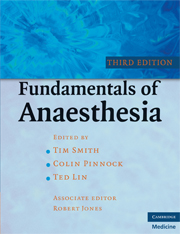Book contents
- Frontmatter
- Contents
- List of contributors
- Preface to the first edition
- Preface to the second edition
- Preface to the third edition
- How to use this book
- Acknowledgements
- List of abbreviations
- Section 1 Clinical anaesthesia
- Section 2 Physiology
- Section 3 Pharmacology
- 1 Physical chemistry
- 2 Pharmacodynamics
- 3 Pharmacokinetics
- 4 Mechanisms of drug action
- 5 Anaesthetic gases and vapours
- 6 Hypnotics and intravenous anaesthetic agents
- 7 Analgesic drugs
- 8 Neuromuscular blocking agents
- 9 Local anaesthetic agents
- 10 Central nervous system pharmacology
- 11 Autonomic nervous system pharmacology
- 12 Cardiovascular pharmacology
- 13 Respiratory pharmacology
- 14 Endocrine pharmacology
- 15 Gastrointestinal pharmacology
- 16 Intravenous fluids
- 17 Pharmacology of haemostasis
- 18 Antimicrobial therapy
- 19 Clinical trials: design and evaluation
- Section 4 Physics, clinical measurement and statistics
- Appendix: Primary FRCA syllabus
- Index
- References
8 - Neuromuscular blocking agents
from Section 3 - Pharmacology
- Frontmatter
- Contents
- List of contributors
- Preface to the first edition
- Preface to the second edition
- Preface to the third edition
- How to use this book
- Acknowledgements
- List of abbreviations
- Section 1 Clinical anaesthesia
- Section 2 Physiology
- Section 3 Pharmacology
- 1 Physical chemistry
- 2 Pharmacodynamics
- 3 Pharmacokinetics
- 4 Mechanisms of drug action
- 5 Anaesthetic gases and vapours
- 6 Hypnotics and intravenous anaesthetic agents
- 7 Analgesic drugs
- 8 Neuromuscular blocking agents
- 9 Local anaesthetic agents
- 10 Central nervous system pharmacology
- 11 Autonomic nervous system pharmacology
- 12 Cardiovascular pharmacology
- 13 Respiratory pharmacology
- 14 Endocrine pharmacology
- 15 Gastrointestinal pharmacology
- 16 Intravenous fluids
- 17 Pharmacology of haemostasis
- 18 Antimicrobial therapy
- 19 Clinical trials: design and evaluation
- Section 4 Physics, clinical measurement and statistics
- Appendix: Primary FRCA syllabus
- Index
- References
Summary
Mechanisms of neuromuscular blockade
The transmission of neuronal impulses to skeletal muscle can be prevented in many ways. These are shown in Figure NJ1.
Drugs acting on the postjunctional nicotinic (acetylcholine) receptors of the skeletal muscle neuromuscular junction are generally used in clinical practice. These may be either depolarising or non-depolarising. The features of an ideal neuromuscular blocking agent are shown in Figure NJ2.
Monitoring neuromuscular blockade
Neuromuscular blockade may be assessed both by clinical observation and by response to electrical stimulation. It is important to consider that any assessment will only measure the function of the particular muscle group tested, and that clinical muscle relaxation may vary considerably in different parts of the body.
Clinical assessment
The presence of adequate neuromuscular function at the end of anaesthesia may be crudely determined by grip strength, by the patient (lying supine) being able to lift their head off the pillow for at least 5 seconds, and by the ability to generate a tidal volume between 15 and 20 ml kg−1.
More precise assessment is required for monitoring during anaesthesia, and this may be especially useful in the recovery period.
Electrical stimulation
Most methods of electrical stimulation employ transcutaneous electrical stimulation of a peripheral nerve (most commonly the ulnar nerve at the level of the forearm). It is important to stimulate the nerve rather than neighbouring muscle.
Stimulation can be performed simply using a single pulse lasting 0.2 ms. However, a train of four such pulses produces more information.
Information
- Type
- Chapter
- Information
- Fundamentals of Anaesthesia , pp. 609 - 619Publisher: Cambridge University PressPrint publication year: 2009
